When filling out the Texas Release of Liability form, individuals often overlook critical details. One common mistake is failing to provide complete personal information. The form requires accurate names, addresses, and contact numbers. Omitting any of these can lead to confusion or complications in the event of a dispute.
Another frequent error involves misunderstanding the scope of the release. People sometimes fail to recognize that the form typically covers only specific activities or events. If the description is vague or incomplete, it may not effectively protect against liability claims.
Many individuals neglect to read the entire document before signing. This oversight can result in agreeing to terms that they do not fully understand. Reading the form carefully ensures that individuals are aware of their rights and responsibilities.
In addition, some people mistakenly believe that a witness signature is unnecessary. While not always required, having a witness can strengthen the validity of the release. This added step can provide extra assurance in case of legal challenges.
Another common mistake is not dating the form. A date is essential for establishing the timeline of the agreement. Without it, questions may arise about when the release was executed, potentially complicating matters later.
Individuals sometimes fail to clarify the legal capacity in which they are signing. For instance, if someone is signing on behalf of a minor, it should be clearly stated. This ensures that the release is valid and enforceable.
People often overlook the importance of using clear and concise language when describing the activities involved. Ambiguities can lead to misinterpretations, which may affect the enforceability of the release. Clarity is key to avoiding future disputes.
Another mistake involves not considering state-specific laws. Each state may have different requirements or implications regarding liability waivers. Familiarity with Texas laws ensures that the release complies with local regulations.
Many individuals also fail to keep a copy of the signed form. Retaining a copy is crucial for personal records. It provides proof of the agreement and can be referenced in case of any issues that arise later.
Finally, some people rush through the process. Taking the time to review and understand the form can prevent many of these mistakes. A careful approach can save individuals from potential legal troubles in the future.
